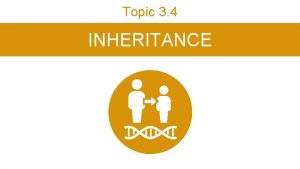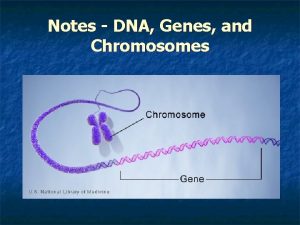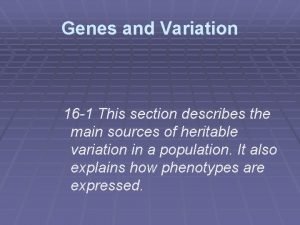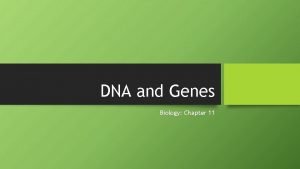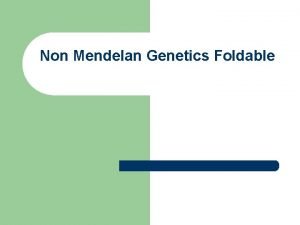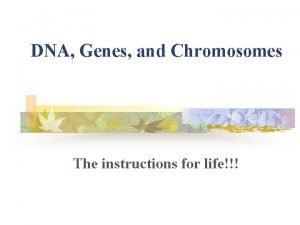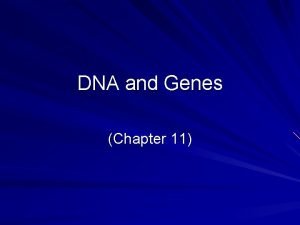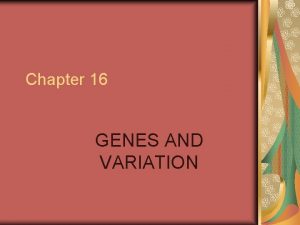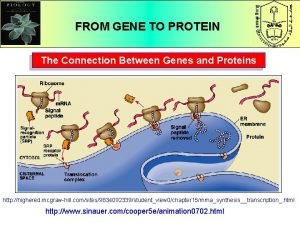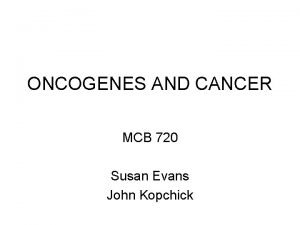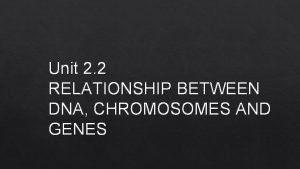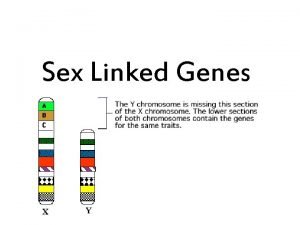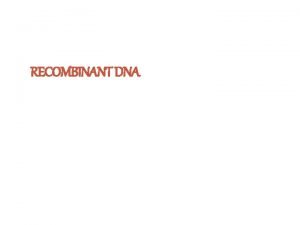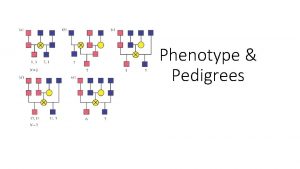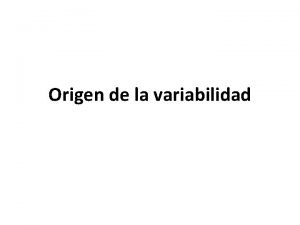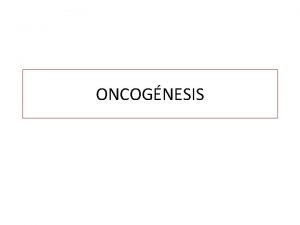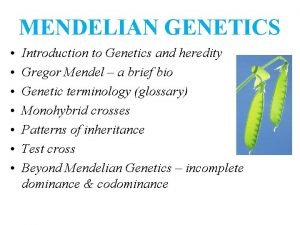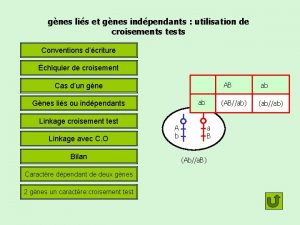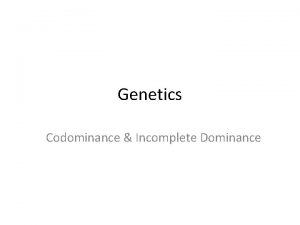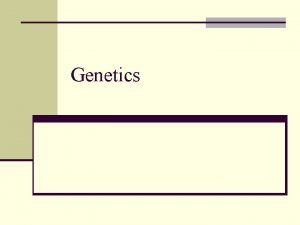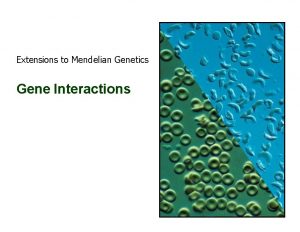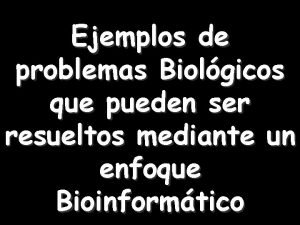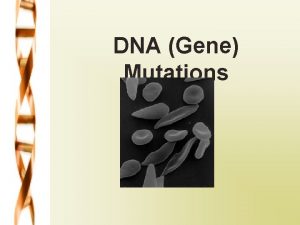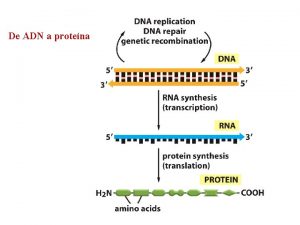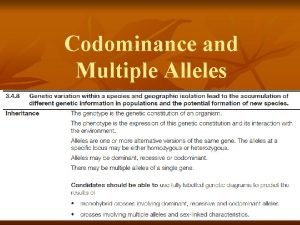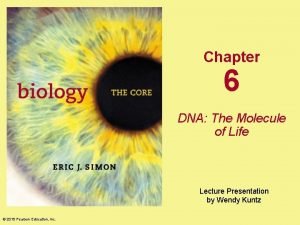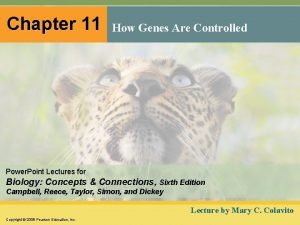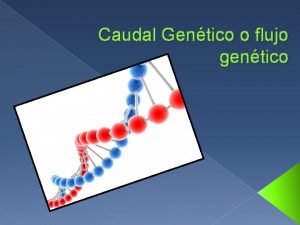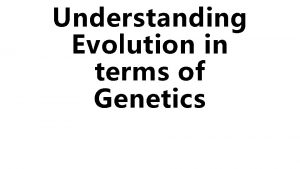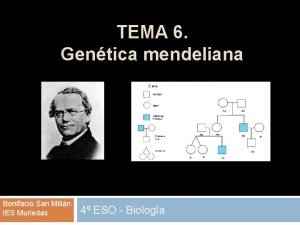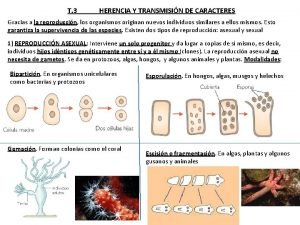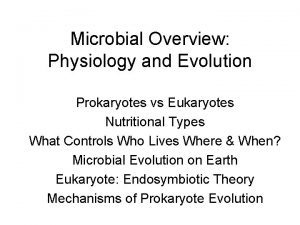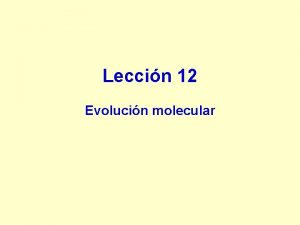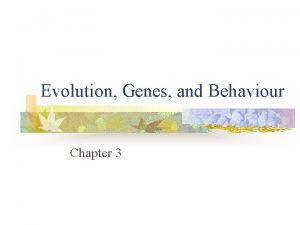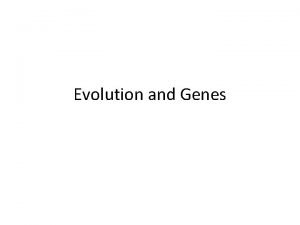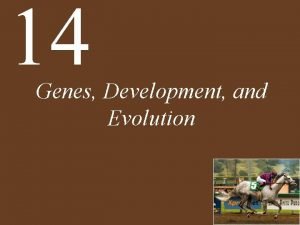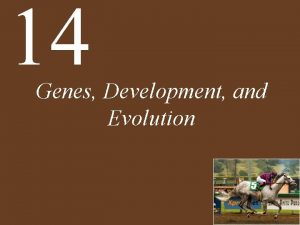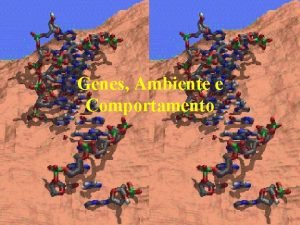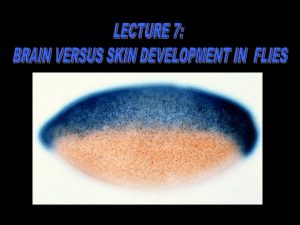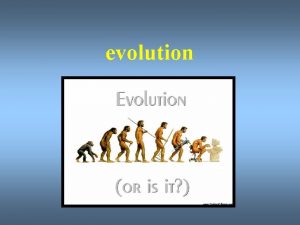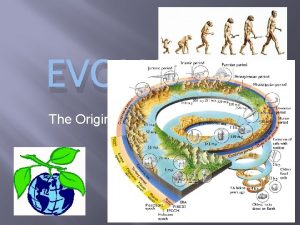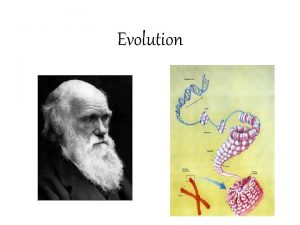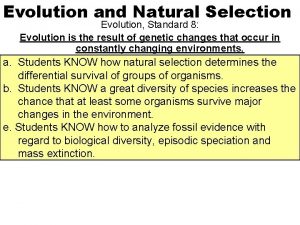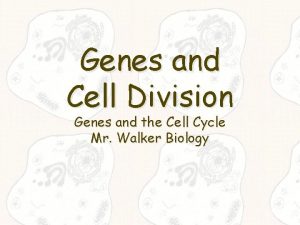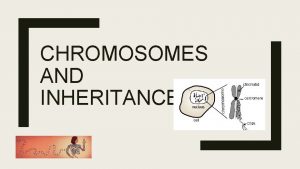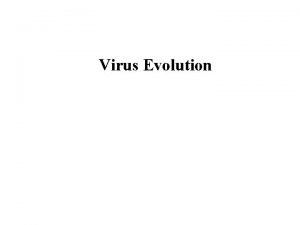20 Genes Development and Evolution 20 Genes Development



























































- Slides: 59

20 Genes, Development, and Evolution

20 Genes, Development, and Evolution 20. 1 How Can Small Genetic Changes Result in Large Changes in Phenotype? 20. 2 How Can Mutations with Large Effects Change Only One Part of the Body? 20. 3 How Can Developmental Changes Result in Differences among Species?

20 Genes, Development, and Evolution 20. 4 How Can the Environment Modulate Development? 20. 5 How Do Developmental Genes Constrain Evolution?

20 Genes, Development, and Evolution Major evolutionary change can result from subtle changes in distribution of signaling molecules and sensitivity of noncoding regions of the DNA that control gene expression. This realization has produced the new field of evolutionary developmental biology. Opening Question: How are gene expression patterns involved in the shaping of the diverse beaks of birds?

20. 1 How Can Small Genetic Changes Result in Large Changes in Phenotype? Study of the relationship between development and evolution has given rise to the new field of evolutionary developmental biology, or evo-devo. Principles: • Organisms share similar mechanisms for development that include a “toolkit” of signaling molecules that control gene expression.

20. 1 How Can Small Genetic Changes Result in Large Changes in Phenotype? • Signaling molecules can act independently in different tissues and regions, enabling modular evolutionary change. • Developmental differences can arise from changes in the timing of signaling molecule action, location of the action, or quantity of the action.

20. 1 How Can Small Genetic Changes Result in Large Changes in Phenotype? • Differences among species can arise from alterations in expression of developmental genes. • Developmental changes can arise from environmental influences.

20. 1 How Can Small Genetic Changes Result in Large Changes in Phenotype? When developmental biologists began to describe differentiation and development at the molecular level, they found common regulatory genes and pathways in many organisms. Example: eye development in fruit flies and mice.

20. 1 How Can Small Genetic Changes Result in Large Changes in Phenotype? Although insect and vertebrate eyes are radically different, research in the 1990 s showed that the genes for eye development are remarkably similar. Gene sequences for eye development are highly conserved in many species. These genes are homologous—they evolved from a gene in a common ancestor.

Figure 20. 1 DNA Sequence Similarity in Eye Development Genes

20. 1 How Can Small Genetic Changes Result in Large Changes in Phenotype? The Hox gene cluster is another example of homology. They code for transcription factors that provide positional information and control pattern formation in body segments. They share a homologous sequence called the homeobox.

20. 1 How Can Small Genetic Changes Result in Large Changes in Phenotype? Hox genes may have arisen via gene duplication—mutated copies can take on new functions while the other maintains original functions. Duplication and divergence of Hox genes is suggested by the increase in the number of Hox genes in different animal groups—from two clusters in jellyfish to four clusters with many genes in vertebrates.

Figure 20. 2 Regulatory Genes Show Similar Expression Patterns

20. 1 How Can Small Genetic Changes Result in Large Changes in Phenotype? Over the millions of years elapsed since cnidarians, insects, and vertebrates last shared a common ancestor, the Hox genes have been conserved. This leads to one of the principles of evo-devo: the shared genetic “toolkit” of developmental mechanisms.

20. 2 How Can Mutations with Large Effects Change Only One Part of the Body? Developing embryos are made up of modules—functional entities consisting of genes, signaling pathways, and the physical structures that result. Developmental genes can be controlled separately in the modules, so structures in different modules can change independently in both developmental and evolutionary time.

20. 2 How Can Mutations with Large Effects Change Only One Part of the Body? Mechanisms called genetic switches control how the genetic toolkit is used. They involve promoters and transcription factors. Multiple switches control each gene; elements of the genetic toolkit can be involved in multiple developmental processes while still allowing individual modules to develop independently.

20. 2 How Can Mutations with Large Effects Change Only One Part of the Body? In an embryo, genetic switches integrate positional information and determine developmental pathways for each module. In Drosophila, the pattern and function of each segment depends on the unique Hox gene or combination of Hox genes that are expressed in that segment.

20. 2 How Can Mutations with Large Effects Change Only One Part of the Body? Example: Wing development In segment 2, Hox gene antennapedia (Antp) results in wing development. In segment 3, Antp is repressed by ultrabithorax (Ubx), and halteres develop instead of wings. If Ubx is mutated, a second set of wings can develop.

Figure 20. 3 Segments Differentiate under Control of Genetic Switches

20. 2 How Can Mutations with Large Effects Change Only One Part of the Body? Modularity allows for differences in expression of structural genes Heterometry: differences in the amount of gene expression. Beak size and shape in Galápagos finches is regulated by the relative amounts of proteins produced by two regulatory genes.

Figure 20. 4 Heterometry and the Beaks of the Finches

20. 2 How Can Mutations with Large Effects Change Only One Part of the Body? Heterochrony: changes in timing of gene expression. Example—neck bones of the giraffe: Bone growth results from proliferation of cells called chondrocytes; growth stops when the cells receive signals for apoptosis. In giraffes, this signaling is delayed in the neck vertebrae, and they grow longer.

Figure 20. 5 Heterochrony in the Development of a Longer Neck

20. 2 How Can Mutations with Large Effects Change Only One Part of the Body? Heterotopy: spatial differences in gene expression. All bird embryos have webbing between the toes, which is retained in ducks but not in chickens. Loss of webbing is controlled by BMP 4, a protein that instructs cells in the webbing to undergo apoptosis.

20. 2 How Can Mutations with Large Effects Change Only One Part of the Body? Cells in both ducks and chickens express BMP 4, but in ducks, a gene called Gremlin, which encodes a BMP 4 inhibitor, is expressed in webbing cells. In chickens, Gremlin is not expressed, and BMP 4 signals apoptosis of the webbing cells. Experimental application of Gremlin to chicken feet results in a webbed foot.

Figure 20. 6 Changes in Gremlin Expression Correlate with Changes in Hindlimb Structure

Figure 20. 7 Changing the Form of an Appendage

20. 3 How Can Developmental Changes Result in Differences among Species? Small differences in expression of developmental genes can produce dramatic differences between species. Mammal species have different numbers of vertebrae in different parts of the vertebral column. This results from the spatial patterns of Hox gene expression.

Figure 20. 8 Changes in Gene Expression and Evolution of the Spine

20. 3 How Can Developmental Changes Result in differences among Species? Heterotypy: changes in the signaling molecule itself, rather than where, how, and when it is expressed. Example: number of legs in arthropods. All arthropods express Distalless (Dll), which controls leg development. The Hox gene Ubx is also expressed in abdominal segments but has different effects on Dll in different species.

20. 3 How Can Developmental Changes Result in differences among Species? In centipedes, Ubx protein activates expression of the Dll gene in abdominal segments, resulting in the formation of legs. In insects, a change in the Ubx gene results in a modified Ubx protein that represses Dll expression in abdominal segments, and no legs are formed.

20. 3 How Can Developmental Changes Result in Differences among Species? This change in Ubx occurred in the ancestor of insects at the same time that abdominal legs were lost.

Figure 20. 9 A Mutation in a Hox Gene Changed the Number of Legs in Insects

20. 3 How Can Developmental Changes Result in Differences among Species? Heterotypy in corn: The wild relative of corn, teosinte, has kernels encased in tough shells that develop under the control of Tga 1. A mutation in Tga 1 results in a protein differing in only one amino acid, resulting in the kernels breaking free.

Figure 20. 10 A Result of Heterotypy

20. 4 How Can the Environment Modulate Development? Environmental signals can produce developmental changes and influence morphology. Developmental plasticity or phenotypic plasticity: a single genotype has the capacity to produce two or more different phenotypes. An organism can modify its development in response to environmental conditions.

20. 4 How Can the Environment Modulate Development? In some reptiles, sex is determined by the temperature at which the eggs are incubated. Higher temperatures produce only females, and lower temperatures produce only males.

Figure 20. 11 Hot Females, Cool Males

20. 4 How Can the Environment Modulate Development? Development of sex organs is controlled by sex steroid hormones, which are synthesized from cholesterol. Both males and females produce testosterone.

In-Text Art, Ch. 20, p. 420

20. 4 How Can the Environment Modulate Development? Incubation temperature controls the expression of the enzyme aromatase. If aromatase is expressed, estrogen dominates and females develop. If aromatase is not expressed, testosterone dominates and males develop. Incubation temperature may affect reproductive success.

Figure 20. 12 Temperature-Dependent Sex Determination Can Be Associated with Sex-Specific Fitness Differences

20. 4 How Can the Environment Modulate Development? In species with short life spans, individuals may encounter different but predictable environments. The moth Nemoria arizonaria has two generations per year. Larvae that hatch in the spring feed on oak flowers and resemble those flowers.

20. 4 How Can the Environment Modulate Development? The second generation feeds on oak leaves and the larvae resemble small oak twigs. A chemical in oak leaves induces them to develop in the twig-like form. The ability to avoid predation by phenotypic plasticity increases evolutionary fitness.

Figure 20. 13 Spring and Summer Forms of a Caterpillar

20. 4 How Can the Environment Modulate Development? Sunlight provides predictive information about seasonal changes and can initiate developmental changes: • Many insects use day length to enter or exit a period of developmental arrest called diapause. • Deer, moose, and elk use day length to time the development and dropping of antlers.

20. 4 How Can the Environment Modulate Development? • Many organisms use day length to optimize timing of reproduction or migration. • Many plants initiate flowering in response to length of night (absence of light). • In some plant species developmental changes are induced by certain wavelengths of light.

20. 4 How Can the Environment Modulate Development? Development includes changes in body form and function that occur throughout the life of the organism. Developmental processes are optimized to adjust for environmental conditions. Light is an important signal for plant development. If grown in dim light, cells in the stem are stimulated to elongate.

Figure 20. 14 Light Seekers

20. 5 How Do Developmental Genes Constrain Evolution? Evolution of form has not been a result of radically new genes but has resulted from modifications of existing genes. Developmental genes constrain evolution in two ways: • Nearly all evolutionary innovations are modifications of existing structures. • Genes that control development are highly conserved.

20. 5 How Do Developmental Genes Constrain Evolution? Example: Wings arose as modifications of existing structures. Wings evolved independently in insects and vertebrates—three times in vertebrates. Vertebrate wings are modified forelimbs.

Figure 20. 15 Wings Evolved Three Times in Vertebrates

20. 5 How Do Developmental Genes Constrain Evolution? Organisms may also lose structures. Ancestors of snakes lost their forelimbs as a result of changes in expression of Hox genes. Then hindlimbs were lost by the loss of expression of the Sonic hedgehog gene in limb bud tissue.

20. 5 How Do Developmental Genes Constrain Evolution? Parallel evolution: Highly conserved developmental genes make it likely that similar traits will evolve repeatedly. Example: three-spined stickleback fish Marine populations return to freshwater to breed; freshwater populations never go into saltwater environments.

20. 5 How Do Developmental Genes Constrain Evolution? Freshwater populations have arisen many times from adjacent marine populations. Marine populations have pelvic spines and bony plates that protect them from predation. These protections are greatly reduced in freshwater populations.

Figure 20. 16 Parallel Phenotypic Evolution in Sticklebacks

20. 5 How Do Developmental Genes Constrain Evolution? One gene, Pitx 1, is not expressed in freshwater sticklebacks, and spines do not develop. This same change in regulatory gene expression has evolved independently in several populations.

20. 5 How Do Developmental Genes Constrain Evolution? The selective mechanism in fresh waters may be that with reduced predation pressure, fish that invest less energy in unnecessary protective structures are more successful.

20 Answer to Opening Question Timing and level of expression of BMP 4 and calmodulin proteins, under the control of transcription factors and their promoters, enhancers, and repressors (the genetic toolkit), result in modifications of birds’ beaks. The same proteins regulate the size and shape of chicken and duck beaks in the same way as the Galápagos finches.
 Linked genes and unlinked genes
Linked genes and unlinked genes Linked genes and unlinked genes
Linked genes and unlinked genes Glomerulus
Glomerulus Evolution of populations section 16-1 genes and variation
Evolution of populations section 16-1 genes and variation Evolution of populations section 16-1 genes and variation
Evolution of populations section 16-1 genes and variation Define community development?
Define community development? Dominant and recessive genes
Dominant and recessive genes Genes chromosomes and dna
Genes chromosomes and dna Dominant and recessive genes
Dominant and recessive genes Genetics is the study of heredity
Genetics is the study of heredity Section 16-1 genes and variation
Section 16-1 genes and variation Chapter 11 dna and genes
Chapter 11 dna and genes Section 16-1 genes and variation
Section 16-1 genes and variation Dominant and recessive genes
Dominant and recessive genes Genetics foldable
Genetics foldable Dna, genes and chromosomes relationship
Dna, genes and chromosomes relationship Dna and genes chapter 11
Dna and genes chapter 11 Section 16-1 genes and variation
Section 16-1 genes and variation What is the connection between genes and proteins
What is the connection between genes and proteins Oncogenes and tumor suppressor genes
Oncogenes and tumor suppressor genes What is the relationship between dna chromosomes and genes
What is the relationship between dna chromosomes and genes Dna rna protein synthesis homework #2 dna replication
Dna rna protein synthesis homework #2 dna replication Flocabulary genes and heredity answer key
Flocabulary genes and heredity answer key X linked traits
X linked traits Tools of recombinant dna technology
Tools of recombinant dna technology Punnett square
Punnett square Codominant genes
Codominant genes Flujo de genes ejemplos
Flujo de genes ejemplos Telangiactasia
Telangiactasia Co dominance
Co dominance Recombinación genética ejemplos
Recombinación genética ejemplos Linked genes
Linked genes Who wrote this
Who wrote this Genes located on the sex chromosomes
Genes located on the sex chromosomes échiquier de croisement gènes liés
échiquier de croisement gènes liés Herencia
Herencia Codominant genes
Codominant genes Bill nye genes worksheet answers
Bill nye genes worksheet answers Genes in a bottle
Genes in a bottle What is additive gene action
What is additive gene action Los transposones son genes móviles en un cromosoma
Los transposones son genes móviles en un cromosoma Genes xenologos
Genes xenologos 5 causes of mutation
5 causes of mutation Agrega
Agrega Codominant
Codominant Chromosome 19
Chromosome 19 The age of genes chapter 6
The age of genes chapter 6 Chapter 11 how genes are controlled reading guide
Chapter 11 how genes are controlled reading guide Caudal genetico
Caudal genetico Genes supresores de tumores
Genes supresores de tumores Genes for blood type
Genes for blood type B rh+ blood type
B rh+ blood type Jumping genes
Jumping genes Bottleneck effct
Bottleneck effct Codominancia y herencia intermedia
Codominancia y herencia intermedia Genes dominantes y recesivos
Genes dominantes y recesivos Genes to traits
Genes to traits Jumping genes
Jumping genes Genes contain instructions for assembling
Genes contain instructions for assembling Paralogo y ortologo
Paralogo y ortologo






